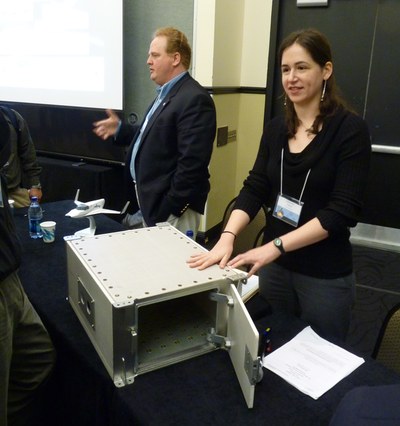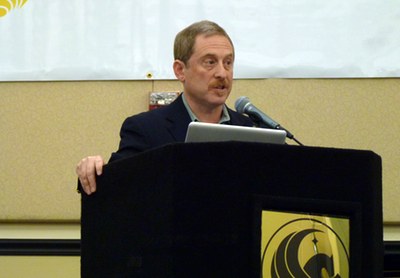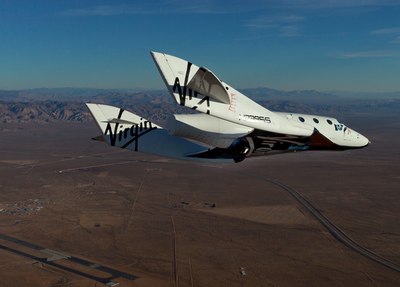Getting down to the nuts and bolts of suborbital researchby Jeff Foust
|
| “The institute agreed to heavily invest in suborbital because of its potential for revolutionizing R&D applications as well as basic science,” Stern said of SwRI’s purchase of several suborbital flights. |
That evolution can be seen in the ongoing development of the field of suborbital research, as performed on the new generation of reusable, often crewed vehicles under active development today (see “Suborbital back out of the shadows”, The Space Review, February 28, 2011). At the first Next-Generation Suborbital Researchers Conference (NSRC), held last February in Colorado, the focus was primarily on examining the different kinds of research that could be carried out on these vehicles; that is, why would scientists be interested in using them? (See “Suborbital research gets ready for liftoff”, The Space Review, March 1, 2010.) At this year’s NSRC, held two weeks ago at the University of Central Florida in Orlando, there were again plenty of sessions on potential research projects that could use these vehicles. However, this year there was arguably a greater emphasis on topics such as payload interfaces and training for prospective suborbital payload specialists—the “how” type of questions that suggest the field is maturing.
“Putting the scientist back in the loop”
Of course, the ultimate sign that a field is maturing is the flow of money into it. At last year’s NSRC, NASA announced that it would provide $15 million a year for its Commercial Reusable Suborbital Research (CRuSR) program, to provide funding for payloads to fly on suborbital vehicles. The CRuSR funding for 2011 is held up by the ongoing budget debate that has left NASA and the rest of the federal government without a final 2011 budget, nearly halfway into the fiscal year. NASA did make small CRuSR awards last August, using 2010 funding, to Armadillo Aerospace and Masten Space Systems for a series of test flights, now planned for the coming weeks in New Mexico and California, respectively.
Meanwhile, one of the biggest advocates for suborbital research is putting his money—or his employer’s money, at least—where his mouth is. At NSRC Alan Stern, the associate vice president of the Southwest Research Institute (SwRI) Space Science and Engineering Division, announced that SwRI had purchased eight seats on future flights of Virgin Galactic’s SpaceShipTwo and XCOR Aerospace’s Lynx. SwRI has purchased six seats on Lynx flights, with an option for three more, as well as two SpaceShipTwo seats, with the option for six more in the form of a dedicated SpaceShipTwo flight.
“The institute agreed to heavily invest in suborbital because of its potential for revolutionizing R&D applications as well as basic science,” Stern said at a February 28 press conference during NSRC, where the deals were formally announced (although XCOR had announced its deal with SwRI the preceding week.) “This is a big first for the research and education market. It’s a big first for suborbital. It’s a big first for Southwest and we think it’s a big first for science in general.”
Stern said the SwRI research program would involve three payload specialists at the institute: Dan Durda, Cathy Olkin, and Stern himself. Their flights would involve some combination of three experiments already developed. One is a biomedical monitor developed for the shuttle program that the payload specialists will wear on all the flights. Another is an experiment to study the properties of asteroid regolith in microgravity, to understand how dust settles in the extremely low gravity of asteroids. A third experiment is the Southwest Ultraviolet Imaging System (SWUIS), a camera that has previously flown on the shuttle, to evaluate the ability of suborbital vehicles to perform astronomical research.
The SwRI contracts are notably for crewed vehicles, even though other vehicles under development to carry research payloads are designed, at least initially, to be uncrewed. Stern said there were two advantages for flying a payload specialist with the experiment: eliminating the need for costly automation of an experiment and allowing the scientist to react to the data in real time and, if necessary, make changes on the fly.
| “The short answer is that the market—that is, you the users and the vehicle providers—will determine what is the vehicle interface,” said NASA’s Kelly. |
“You’re sort of groping around a little bit in the dark” when flying automated payloads, said Josh Colwell, associate professor at the University of Central Florida who developed the microgravity regolith experiment. That experiment was originally designed to be automated for shuttle flights as well as future flights on Blue Origin’s New Shepard suborbital vehicle, but he said there are clear advantages of having a scientist operate the experiment during the flight and adjust it in real time. “You have the potential to get the data you really need in a smaller number of flights.”
“It very well illustrates some of the power of suborbital,” said Stern. “We’re putting the scientist back into the loop, like in any other scientific profession.”
 Annemarie Askren of Blue Origin (foreground) shows off her company’s Cabin Payload Bay for hosting experiments, while XCOR COO Andrew Nelson (background) discusses payload oportunities on his company’s Lynx vehicle after a panel session at NSRC. (credit: J. Foust) |
Developing payload interfaces
One challenge suborbital researchers face, whether their payloads are flying on crewed or uncrewed vehicles, is how to install their payloads on these vehicles. The wide range of vehicle designs, and the lack of interface standards for such experiments, pose a challenge for vehicle developers and experimenters alike.
XCOR Aerospace, for example, offers a variety of accommodations for payloads. The largest space in the vehicle would take the place of the spaceflight participant’s seat on the two-seat vehicle, and would be large enough to accommodate shuttle middeck lockers. There’s a smaller area inside the cabin behind the pilot’s seat, and externally two canisters near the vehicle’s tail for upper atmospheric sampling of ejection of payloads. There’s also what XCOR COO Andrew Nelson dubs the “ski rack”: an external payload carrier on top of the vehicle that could be used “for a lot of interesting experiments” that require exposure to space.
Blue Origin, meanwhile, is seeking to develop its own standard for payloads to make it easier for potential research customers. The company has developed what it calls the Cabin Payload Bay, a standard module designed to accommodate a wide range of payloads, with a set of power and data interfaces. “The overall approach that Blue Origin takes towards payload integration is essentially a ‘plug-and-play’ capability,” said Annamarie Askren, the research and education market payload integration lead at Blue Origin. “We prefer the researchers—you—dedicate your time to your experiment, rather than to a lengthy, logistically difficult integration process.”
| “If it doesn’t require it, I’d recommend just sitting strapped into your seat,” said Durda of weightlessness. “It’s a much more efficient way to get your work done.” |
“The payload integration process for us is very simple,” said Masten Space Systems founder Dave Masten. The company wants to keep it simple, he said, to allow for rapid flight rates and quick changes of payloads. Masten’s initial CRuSR award has led to the development of a small payload rack, which they’ve successfully tested with an FAA ADS-B transponder that Masten will fly on its upcoming CRuSR launches.
Masten’s work with NASA on that effort, though, doesn’t mean that the agency is interested in establishing specific payload interface standards. “The short answer is that the market—that is, you the users and the vehicle providers—will determine what is the vehicle interface,” said John Kelly, the manager for NASA’s Flight Opportunities program, which includes CRuSR. “Our job in the Flight Opportunities Program is to try to bring the two sides of that market together.”
 Alan Stern told NSRC attendees that training for suborbital payload specialists should take no more than about one to three weeks. (credit: J. Foust) |
Training payload specialists
For those experiments that will fly with a payload specialist, there’s another major issue: how much training should that person get? Presumably he or she will require more than the few days that companies are currently planning for space tourists, but less than the years of training that NASA astronauts undergo for missions to Earth orbit, but exactly where in-between suborbital payload specialist training lies isn’t clear yet.
“The suborbital environment is going to be a little less forgiving of real-time failures compared to our experience on parabolic aircraft,” said SwRI’s Durda. “Along with that, there is the inherent need for additional preparation and pre-planning and pre-thinking.”
Given the short duration of suborbital flights—with on the order of five minutes of microgravity time—payload specialists have to be trained to work efficiently, something that will be particularly challenging given the work environment. “You’re going to have a lot of distractions. You’re going to have spectacular views,” Durda said. “Focusing on your task at hand is really paramount.”
For training, Durda recommends getting experience in as many different environments as possible, be it piloting aircraft, scuba diving, or other activities, building up proficiency over time. “All of them, in one way or another, bring experience to you,” he said.
One specific area of experience he does recommend is flying on parabolic aircraft to get some exposure to weightlessness. “I cannot imagine any researcher trying to accomplish a focused task on a suborbital flight without having gone through” the experience those flights provide. However, he said that although the exposure to weightlessness is a big selling point for tourist suborbital flights, it may be distraction best avoided by researchers. “If it doesn’t require it, I’d recommend just sitting strapped into your seat. It’s a much more efficient way to get your work done.”
Others, though, have proposed much more rigorous training regimens for prospective suborbital payload specialists. Erik Seedhouse, chief training officer for Astronauts4Hire, a company planning to train a corps of commercial astronauts to perform suborbital research for scientists, described a training program they have developed. That program includes parabolic flights and centrifuge training, as well as various types of open water and wilderness survival training and aerobatic flights, among other activities. These activities, he said, were intended in part to expose people to unfamiliar, even potentially dangerous situations and see how they react. “You may think some of this is excessive, but it isn’t,” he said. “What we’re trying to do is train our members to be efficient in all types of training environments so we can go to any operator, or any operator can come to us.”
Stern, though, was skeptical that that level of rigor is required for suborbital payload specialists. “The key for us as an industry is to find the sweet spot in training where we keep the costs low and the commitment low for the payload specialists and the provider companies,” he said. “Because if we turn this into training that looks like you’re going on an International Space Station mission, we’re really going to be in trouble. We’re defeating the purpose of low-cost spaceflight.”
| “The key for us as an industry is to find the sweet spot in training where we keep the costs low and the commitment low for the payload specialists and the provider companies,” Stern said. |
He sees four different classes of training needed for payload specialists: simple vehicle familiarity and emergency procedures that anyone, including tourists, would get; training for the various environments experienced during the flight, including both weightlessness and the high-g phases of flight; familiarity with the experiments being flown; and interpersonal training with other members of the crew. “I would think to get ready for a first flight, beyond what you have to do with your own equipment, the sweet spot is probably something like one, two, or three weeks” spread out over a longer period of time, Stern said.
A separate issue for payload specialists is the perception by some that scientists are interested in suborbital flight opportunities primarily because they want to experience spaceflight. “It’s not just because people want to fly in space, but I don’t think you should be ashamed of that, either,” Stern said. He noted that in other scientific fields, researchers enjoy going out in the field: astronomers to mountaintop observatories, oceanographers on ships, and geologists in terrains spanning the globe. The same should be true in suborbital science, and scientists should not be reticent to enjoy it. “It’s not a conflict of interest, it’s part of what we do.”
When Stern and his SwRI colleagues, as well as other potential customers, will actually get to enjoy their suborbital spaceflight experiences, isn’t known yet, given the uncertainties about vehicle development schedules. “In both cases we have some people ahead of us, but we’re not at the end of the queue,” Stern said of SwRI’s contracts with Virgin and XCOR. “I’m pretty confident that a couple NSRCs down the road—two, not four—we’ll be showing flight results.” By that time the discussion at the conference will have shifted again, from how to do the science to what results those experiments can provide in a potentially wide range of scientific fields.
